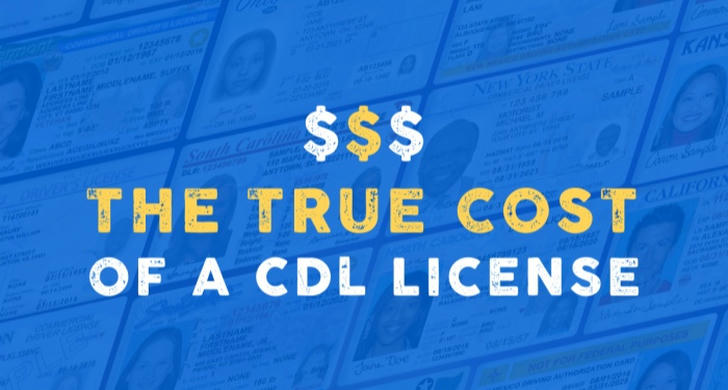HOW MUCH DOES IT COST TO GET A CDL?
Thinking about starting a career as a commercial driver? A Commercial Driver’s License (CDL) is necessary to get started. Before diving in, it’s important to understand the financial commitment involved. From training costs to licensing fees, here is everything needed to know about the costs associated with getting a CDL in the U.S.

What is a CDL and Why is it Necessary?
A CDL allows operation of large vehicles like semi-trucks and buses, which regular driver’s licenses don’t cover. There are three main classes of CDLs—Class A, B, and C—each qualifying for different types of vehicles. Anyone aiming to drive commercial heavy vehicles needs this license, making it a gateway to numerous job opportunities in various sectors.
Overview of CDL Training Costs
The road to a CDL starts with Entry Level Driver Training, which can be obtained through private driving schools, community colleges, or company-sponsored programs. The program must be listed on the FMCSA Training Provider Registry. The costs vary:
Private school CDL training tuition ranges between $3,000 and $7,000 for a comprehensive course.
Community colleges may offer more affordable options at around $1,000 to $5,000, depending on the length and depth of the training, although the training period may be longer.
Company-sponsored training might be offered without upfront cost, often with a commitment to work for the company for a specified period.
Examination and Licensing Fees
To obtain a CDL, both written and skills tests must be passed. Typical expenses include:
Written exams usually cost about $5 to $20 per attempt.
Skills testing can range from $30 to $100.
Additional endorsements (e.g., hazardous materials, tankers) require separate endorsement tests, with extra fees.
Additional Costs to Get a CDL
Other expenses include:
Medical examinations and drug screenings, costing anywhere from $50 to $150.
Driving record checks and background checks, adding approximately $10 to $40.
CDL Training Availability Across All 50 States
CDL training programs are widely available throughout all 50 U.S. states, making it accessible no matter the location. Whether in large metropolitan areas or rural communities, aspiring drivers can find options nearby to fit their schedules and budgets. This widespread coverage ensures that individuals from every state can pursue commercial driving careers without relocating.
No Experience? No Problem
Many paid CDL training programs welcome individuals with no prior driving experience. These programs provide comprehensive instruction from the basics through to advanced commercial vehicle operation. With structured training designed for beginners, candidates can gain the skills needed to pass licensing exams and start their driving careers confidently.
Age Groups and Audience
CDL training is open to a broad age range. Below is a breakdown of typical age groups eligible for CDL training and related driving permissions:
| Age Range | CDL Eligibility | Driving Restrictions | Notes |
|---|---|---|---|
| 18 - 20 years | Eligible for CDL with intrastate driving | Restricted to driving within the state | Cannot drive interstate commercial vehicles |
| 21 years and up | Eligible for full CDL including interstate driving | No restrictions | Can drive commercial vehicles across state lines |
| 30 years and up | Eligible for CDL | No restrictions | Many career changers and older adults start at this age |
| 50 years and up | Eligible for CDL | No restrictions | Some programs cater to older adults seeking new careers |
This flexibility allows diverse age groups—from young adults just entering the workforce to experienced adults seeking career changes—to benefit from commercial driving opportunities.
Long-term Investment vs. Immediate Costs
Though initial costs might seem high, obtaining a CDL is a significant investment. Truck drivers’ average salaries often range between $76,000 and $95,000 per year,* depending on experience, location, and employer.
Compared to traditional four-year college degrees, the financial and time commitments for a CDL are substantially less.
Cost Comparison: CDL vs. Four-Year Degree
CDL Training Costs: Between $1,000 and $7,000 depending on program type and length.
Four-Year College Degree: According to the College Board, average annual tuition and fees for four-year institutions are about $10,560 for state residents at public colleges and $37,650 at private colleges. Over four years, total costs range from approximately $42,240 to $150,600.
Time to Start Earning
CDL: Training programs can last from 3 weeks up to about 3 months, allowing earning potential to begin within a month of starting training. Starting salaries typically range from $76,000 to $95,000 per year, with opportunities to increase based on endorsements, experience, and routes.
Four-Year Degree: Requires four years to complete, with potential debt accumulation and no guaranteed immediate employment upon graduation.
Getting a CDL is a Good Return on Investment
Investing about $7,000 in CDL training with a starting salary of approximately $69,000 means training costs can be recouped within a fraction of the first year’s earnings. In contrast, college degrees may take years to break even due to higher costs and variable salaries.
Now that all costs involved in obtaining a CDL are clear, it’s time to weigh these against potential earnings and career opportunities. For those interested in commercial driving as a career path, planning a budget and preparing for training are the next steps.
